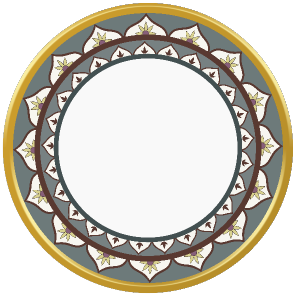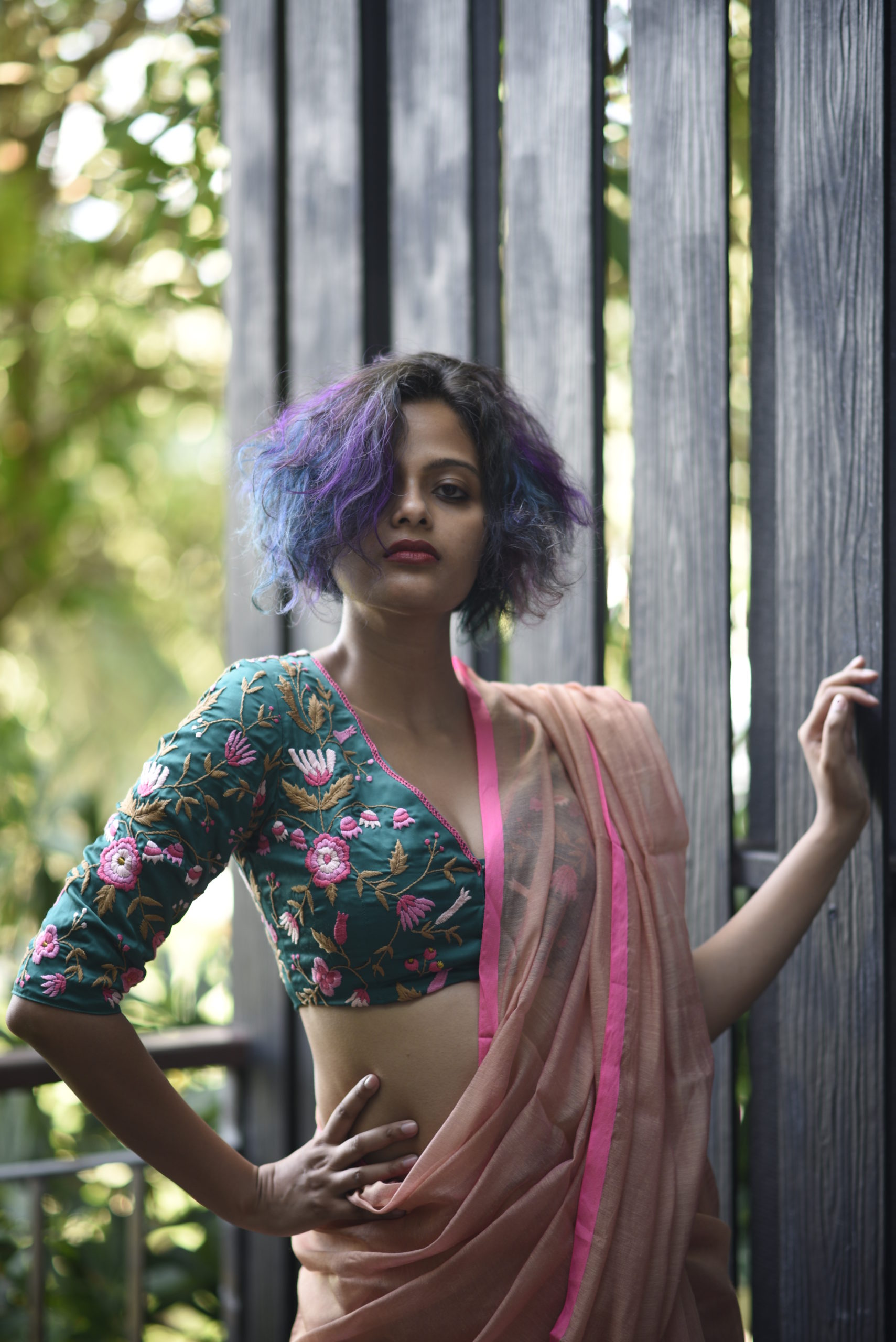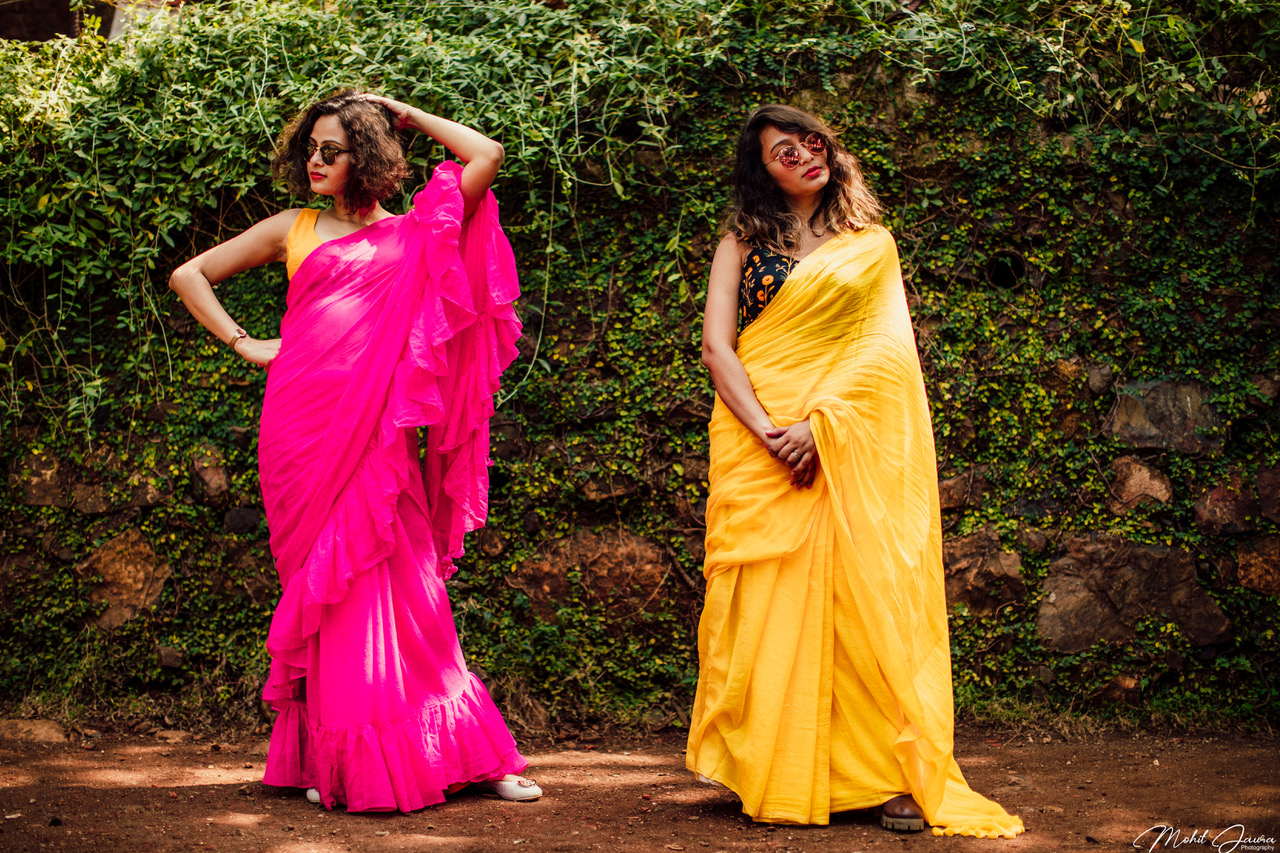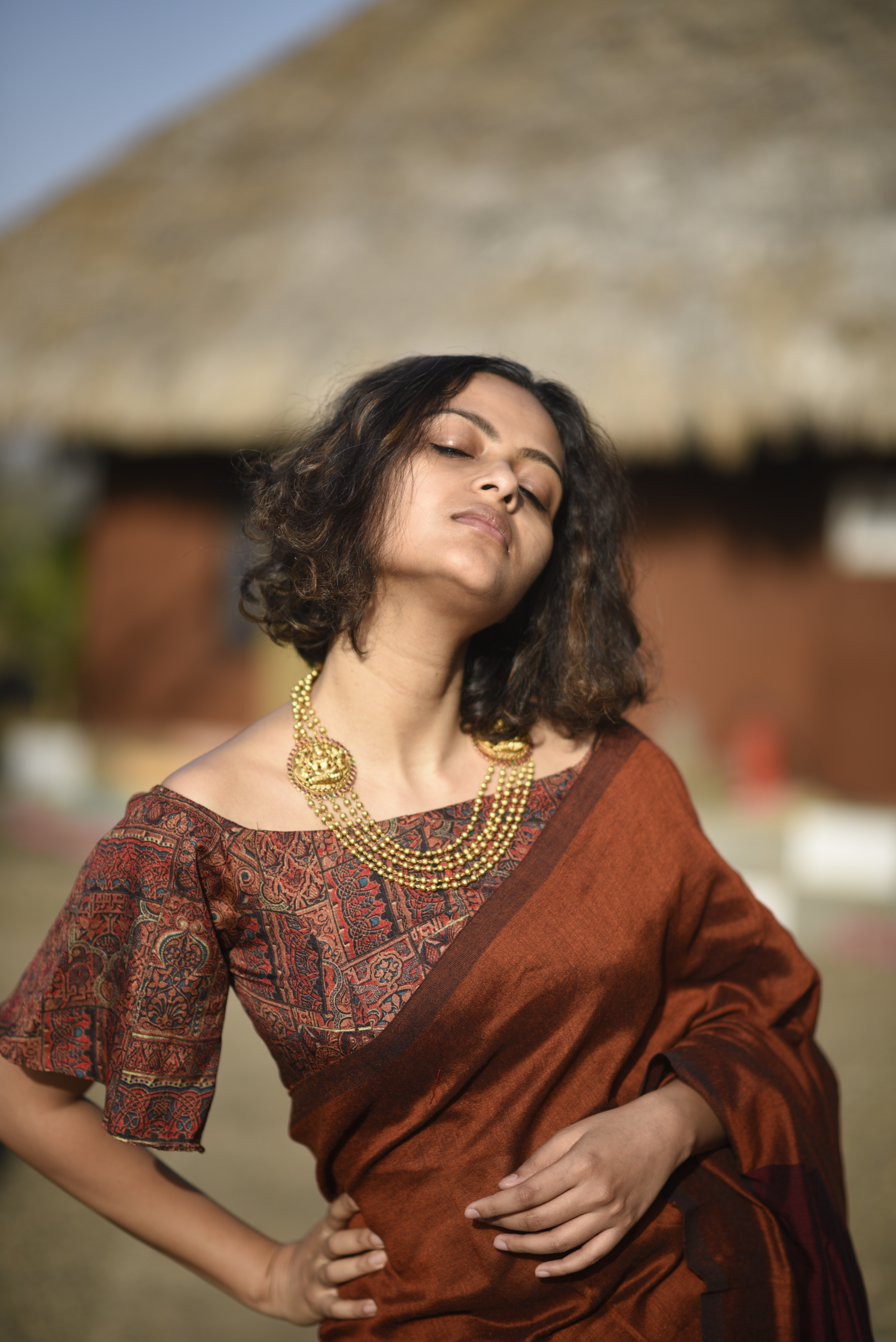

0


0

FASHION
By Admin
10 July, 2019

 BV: How Suta is reviving the fabric and empowering the artistry? Would you like to take the readers through the process?
Sujata & Taniya: We are always working on a lot of different art forms. For instance, there is a huge misconception that Kantha sarees are very expensive because obviously, it’s a time-consuming process. For example, Kantha is inspired by nature, like flowers or animals, and it's very intricately drawn and stitched on the saree. What we have thought is how to make sure that the kantha reaches everyone's cupboard and it becomes affordable. So what we are doing is, we are reducing design to a smaller sections like, border of the saree or just the anchal of the saree, making it smaller so that, weavers earn from it and so that they don't have to leave their much-celebrated art form and tradition which they have known and learned from their mothers and grandmothers.
Many weavers discontinued working as they didn't get many orders. We have tried to bridge this and have been working on giving them plenty of orders but in small forms of saree or blouse. We want more people to own the saree and eventually, weavers also get a lot of work. We are also doing Pattachitra in Odissa. It's a very intricate brush technique with extraordinary narration and rich colors. If one opts to buy Pattachitra paintings, they cost about a few lacs per painting. We have done something similar, we have reduced the art form to smaller parts, similar to kantha. Very little work, but then very intricate and very smaller segments. People who understand and love Pattachitra can have these sarees forever and pass it on to generations. These are treasures you want to keep in your cupboard. Similarly again Mulkhesh is another technique that we follow, which is like using old sarees which are not sold to make fresh sarees. In the making of this saree they just tear the old sarees and use it while weaving a new saree. When you look at this saree, you will notice the different colour lines on the saree all over. That is the beauty of this saree, it looks like an art form and is sustainable as well. It also abides by our motto of less wastage. We ensure that any amount of materials that is left over is donated to NGOs who can use it for some purpose. We donated a huge number of fabric to rotary clubs. Our future plan is to do a section on the SuTa website, where we can sell small bandanas or handkerchiefs from all the fabric which goes as waste. We keep doing such things which help people/weavers in monetary and non - monetary ways.
BV: What different does SuTa deliver to its customers when there are many ventures that deliver handloom products and help the artisans or weavers to earn their own bread?
Sujata & Taniya: We believe in inclusive empowerment. We believe in including the entire family of weavers and their generations as well as the neighbors in the process of making something which we all love. Sarees are dipped in love and actually, we do believe that every piece is created to be loved and then delivered to the customers. Hence every piece is checked thoroughly, ironed, packed with a lot of love, care. Also by inclusion, we mean that we get those family members who don’t know how to weave, to make tassels or embroider the fabric. We give them training so that they can develop their skills and be empowered. We don't just look at artisans who are very skilled to weave sarees but try to give a variety of work to the others as well and help them earn a livelihood. A lot of people come to us asking for work. They want to help us with what they can and love to work with Suta. We come across young girls who have studied till 5th or 6th grade and later didn't study further for many years. We realized that their skill at hand painting and started a range of hand-painted sarees with them. Most importantly, it's not just about making handloom sarees but it’s the entire process. For one of our powerloom categories, Made in heaven sarees, the entire saree making process is around 8 to 10 days out of which, we have reduced a couple of days by using semi-automated process. It’s still a handmade saree where 60%- 70% of the work is still done by hand. We try to experiment. We make sure that the things we make should be loved by people. Our idea has always been to make sure the weavers' hardship decreases, they earn more and love working with us.
BV: How Suta is reviving the fabric and empowering the artistry? Would you like to take the readers through the process?
Sujata & Taniya: We are always working on a lot of different art forms. For instance, there is a huge misconception that Kantha sarees are very expensive because obviously, it’s a time-consuming process. For example, Kantha is inspired by nature, like flowers or animals, and it's very intricately drawn and stitched on the saree. What we have thought is how to make sure that the kantha reaches everyone's cupboard and it becomes affordable. So what we are doing is, we are reducing design to a smaller sections like, border of the saree or just the anchal of the saree, making it smaller so that, weavers earn from it and so that they don't have to leave their much-celebrated art form and tradition which they have known and learned from their mothers and grandmothers.
Many weavers discontinued working as they didn't get many orders. We have tried to bridge this and have been working on giving them plenty of orders but in small forms of saree or blouse. We want more people to own the saree and eventually, weavers also get a lot of work. We are also doing Pattachitra in Odissa. It's a very intricate brush technique with extraordinary narration and rich colors. If one opts to buy Pattachitra paintings, they cost about a few lacs per painting. We have done something similar, we have reduced the art form to smaller parts, similar to kantha. Very little work, but then very intricate and very smaller segments. People who understand and love Pattachitra can have these sarees forever and pass it on to generations. These are treasures you want to keep in your cupboard. Similarly again Mulkhesh is another technique that we follow, which is like using old sarees which are not sold to make fresh sarees. In the making of this saree they just tear the old sarees and use it while weaving a new saree. When you look at this saree, you will notice the different colour lines on the saree all over. That is the beauty of this saree, it looks like an art form and is sustainable as well. It also abides by our motto of less wastage. We ensure that any amount of materials that is left over is donated to NGOs who can use it for some purpose. We donated a huge number of fabric to rotary clubs. Our future plan is to do a section on the SuTa website, where we can sell small bandanas or handkerchiefs from all the fabric which goes as waste. We keep doing such things which help people/weavers in monetary and non - monetary ways.
BV: What different does SuTa deliver to its customers when there are many ventures that deliver handloom products and help the artisans or weavers to earn their own bread?
Sujata & Taniya: We believe in inclusive empowerment. We believe in including the entire family of weavers and their generations as well as the neighbors in the process of making something which we all love. Sarees are dipped in love and actually, we do believe that every piece is created to be loved and then delivered to the customers. Hence every piece is checked thoroughly, ironed, packed with a lot of love, care. Also by inclusion, we mean that we get those family members who don’t know how to weave, to make tassels or embroider the fabric. We give them training so that they can develop their skills and be empowered. We don't just look at artisans who are very skilled to weave sarees but try to give a variety of work to the others as well and help them earn a livelihood. A lot of people come to us asking for work. They want to help us with what they can and love to work with Suta. We come across young girls who have studied till 5th or 6th grade and later didn't study further for many years. We realized that their skill at hand painting and started a range of hand-painted sarees with them. Most importantly, it's not just about making handloom sarees but it’s the entire process. For one of our powerloom categories, Made in heaven sarees, the entire saree making process is around 8 to 10 days out of which, we have reduced a couple of days by using semi-automated process. It’s still a handmade saree where 60%- 70% of the work is still done by hand. We try to experiment. We make sure that the things we make should be loved by people. Our idea has always been to make sure the weavers' hardship decreases, they earn more and love working with us. BV: Who will assist in designing? From where do the designs get inspired?
Sujata & Taniya: We get inspired by nature, people we meet and what we see around us. While designing we keep in mind that everything on the saree should take shape of that person and become the personality, that's how we launch it too. Everyday life, our travel escapades inspire us to come out with new designs and ideas. Recently, we had two designers who joined us from whom we are learning a lot. We are exploring a different kind of techniques and art forms. We don’t want to work according to any trends that are happening because we completely believe in a sustainable fashion. We firmly believe that sarees and blouses are unique pieces of art which should be preserved. Our designers too share our philosophy and that's the how we design things.
BV: How many people do you have in your team? Would you like to introduce them?
Sujata & Taniya: We would love to introduce our big team to you. We have a staff of 35 and 900+ weavers as well as craftsmen /craftswomen. It’s an ever-growing team. It is difficult to introduce all of them at one go. Regarding the team members, we have a new page coming up on our website which highlights each one of them along with their photographs and how they are adding value to SuTa. We will keep coming live on Facebook/Insta with the team around us and introduce you to each of them. Interestingly some of our long-time customers have started working with us taking the relationship to a new level because they love and understand the brand. Clients who visit our office have met them. We are just naming a few of the members such as Raksha, Aliyah, Anita, Jaya, Priyanka, Sonali, Shradha, Suparna Kundu. it's a long list and 60% of the team consists of women.
BV: Who are your target audience? Is it only the saree wearing tribe or you focus on the ones that prefer to wear apparels of the same fabric?
Sujata & Taniya: Our product is such that even a 14-year-old girl can wear for farewell parties or a 70-year-old lady can wear it for her school reunion. Suta sarees can be worn for a party, to a brunch, to office or weddings. We do not look at targeting any gender, age or any particular function. We want sarees to become a regular affair. Suta sarees are very light, breathable, wearable and versatile. Most of our customers are office goers, teachers, and doctors. Lately, we have noticed customers between the age of 14-22 years. Men and Women in the age group of 25-50 years buy regularly. Women in this age group buy regularly online and they are the most critical of our target audience. And also the common thing amongst all the women is that they are the decision-makers, they love taking their own decisions. The age group is vast because women also buy sarees and gift them hence it has reached maximum cupboards which itself is a big testimonial.
BV: Who will assist in designing? From where do the designs get inspired?
Sujata & Taniya: We get inspired by nature, people we meet and what we see around us. While designing we keep in mind that everything on the saree should take shape of that person and become the personality, that's how we launch it too. Everyday life, our travel escapades inspire us to come out with new designs and ideas. Recently, we had two designers who joined us from whom we are learning a lot. We are exploring a different kind of techniques and art forms. We don’t want to work according to any trends that are happening because we completely believe in a sustainable fashion. We firmly believe that sarees and blouses are unique pieces of art which should be preserved. Our designers too share our philosophy and that's the how we design things.
BV: How many people do you have in your team? Would you like to introduce them?
Sujata & Taniya: We would love to introduce our big team to you. We have a staff of 35 and 900+ weavers as well as craftsmen /craftswomen. It’s an ever-growing team. It is difficult to introduce all of them at one go. Regarding the team members, we have a new page coming up on our website which highlights each one of them along with their photographs and how they are adding value to SuTa. We will keep coming live on Facebook/Insta with the team around us and introduce you to each of them. Interestingly some of our long-time customers have started working with us taking the relationship to a new level because they love and understand the brand. Clients who visit our office have met them. We are just naming a few of the members such as Raksha, Aliyah, Anita, Jaya, Priyanka, Sonali, Shradha, Suparna Kundu. it's a long list and 60% of the team consists of women.
BV: Who are your target audience? Is it only the saree wearing tribe or you focus on the ones that prefer to wear apparels of the same fabric?
Sujata & Taniya: Our product is such that even a 14-year-old girl can wear for farewell parties or a 70-year-old lady can wear it for her school reunion. Suta sarees can be worn for a party, to a brunch, to office or weddings. We do not look at targeting any gender, age or any particular function. We want sarees to become a regular affair. Suta sarees are very light, breathable, wearable and versatile. Most of our customers are office goers, teachers, and doctors. Lately, we have noticed customers between the age of 14-22 years. Men and Women in the age group of 25-50 years buy regularly. Women in this age group buy regularly online and they are the most critical of our target audience. And also the common thing amongst all the women is that they are the decision-makers, they love taking their own decisions. The age group is vast because women also buy sarees and gift them hence it has reached maximum cupboards which itself is a big testimonial. BV: What are the activities you have done to showcase your brand or your products?
Sujata & Taniya: We celebrate each and every customer of ours by calling them Suta queens on our social media. It is an activity we started initially and is on-going. We share their stories and want women to get inspired by each other. We want to celebrate every person irrespective of who they are or how they are, the kind of love people showered on us by sharing the pictures and the reviews about the product is immense and make us feel blessed each day, every day. We recently organized a flash sale and preview of a new collection in Suta’s physical store in Mumbai, the idea of the sale was to give 2% of the sale to the weavers. We did a small briefing session about our weavers and how we like to bring a difference in their lives. It was the first of its kind activity, we got a lot of love and have plans to do more of such activities. We have a few in the pipeline.
BV: Your future plans.
Sujata & Taniya: We aim to make Suta accessible to every household in India and preserve the indigenous art form and talent. The second and most important goal we have is of sustainability and celebrate slow fashion. Every piece of cloth should be celebrated. There is a lot of potential for sustainable fashion and it is quickly picking up. We have been thinking of getting into AYUR VASTRA. An AYUR VASTRA cloth is completely organic, sustainable and biodegradable. Our aim is to educate more and more people about the kind of work that happens in the villages so that they start respecting the fabric and know what they wear.
To know more such incredible Indian fashion brands, follow us on Facebook, Instagram, and Twitter. Download our digital magazine Spunky Indian for exclusive stories.
BV: What are the activities you have done to showcase your brand or your products?
Sujata & Taniya: We celebrate each and every customer of ours by calling them Suta queens on our social media. It is an activity we started initially and is on-going. We share their stories and want women to get inspired by each other. We want to celebrate every person irrespective of who they are or how they are, the kind of love people showered on us by sharing the pictures and the reviews about the product is immense and make us feel blessed each day, every day. We recently organized a flash sale and preview of a new collection in Suta’s physical store in Mumbai, the idea of the sale was to give 2% of the sale to the weavers. We did a small briefing session about our weavers and how we like to bring a difference in their lives. It was the first of its kind activity, we got a lot of love and have plans to do more of such activities. We have a few in the pipeline.
BV: Your future plans.
Sujata & Taniya: We aim to make Suta accessible to every household in India and preserve the indigenous art form and talent. The second and most important goal we have is of sustainability and celebrate slow fashion. Every piece of cloth should be celebrated. There is a lot of potential for sustainable fashion and it is quickly picking up. We have been thinking of getting into AYUR VASTRA. An AYUR VASTRA cloth is completely organic, sustainable and biodegradable. Our aim is to educate more and more people about the kind of work that happens in the villages so that they start respecting the fabric and know what they wear.
To know more such incredible Indian fashion brands, follow us on Facebook, Instagram, and Twitter. Download our digital magazine Spunky Indian for exclusive stories.